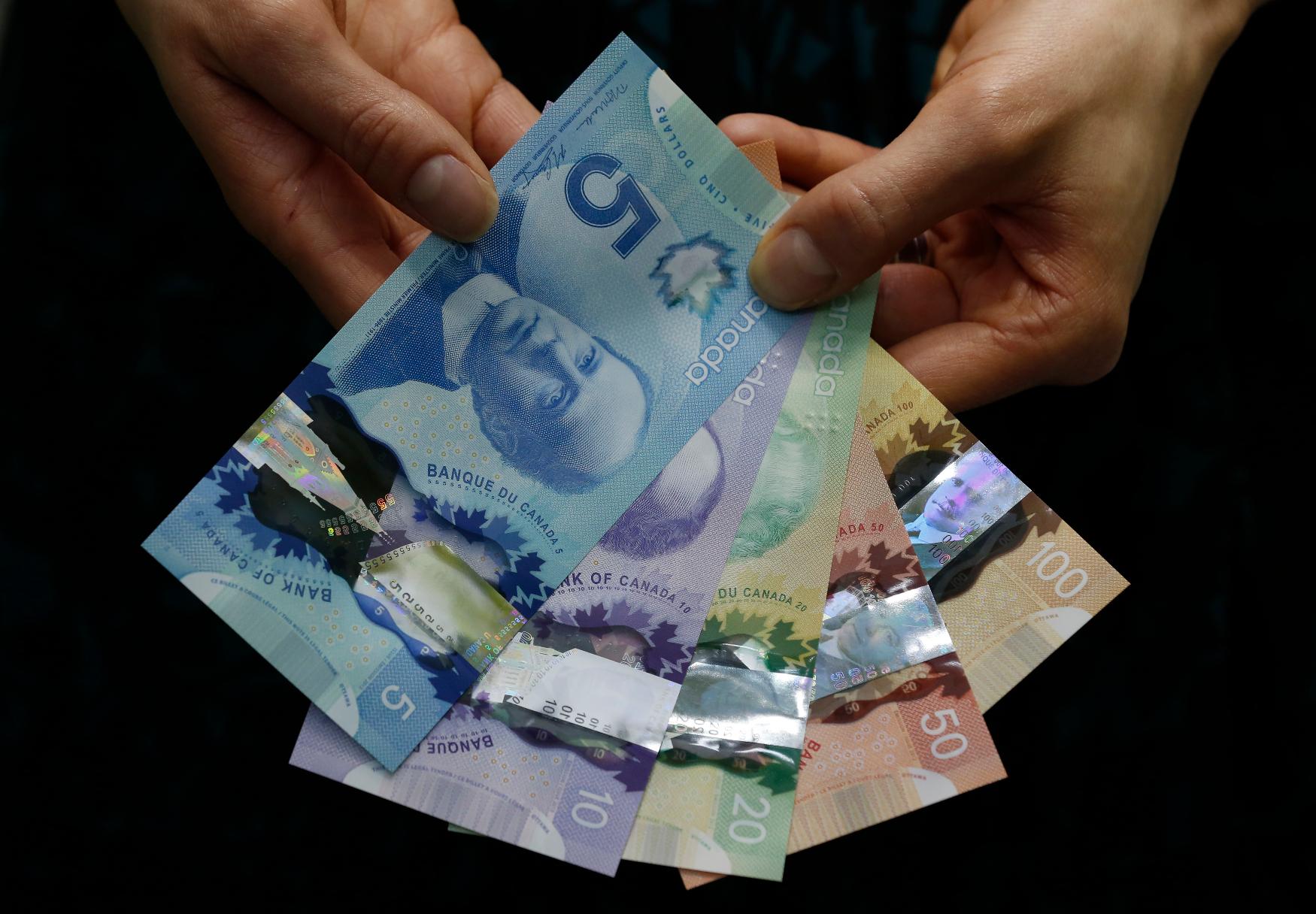
2024-08-22 16:02
Canadian dollar weakens 0.1% against the greenback Pulls back from a 4-month high at 1.3572 Canada's top two railroads lock out workers Bond yields rise across the curve TORONTO, Aug 22 (Reuters) - The Canadian dollar edged lower against its U.S. counterpart on Thursday, pulling back from a four-month high, as the greenback notched broad-based gains and a work stoppage at Canada's top two railroads threatened to disrupt the domestic economy. The loonie was trading 0.1% lower at 1.3605 to the U.S. dollar, or 73.50 U.S. cents, after touching its strongest intraday level since April 10 at 1.3572. Canadian National Railway Co (CNR.TO) , opens new tab and Canadian Pacific Kansas City Ltd (CP.TO) , opens new tab locked out more than 9,000 unionized workers, triggering an unprecedented rail stoppage that could cause billions of dollars worth of economic damage. "The rail shutdown now underway should instill a growing sense of alarm in those holding bullish (Canadian dollar) positions," Karl Schamotta, chief market strategist at Corpay, said in a note. "With the federal government thus far refusing to intercede in negotiations between Canadian National Railway, Canadian Pacific Kansas City, and the Teamsters union, the prospect of a prolonged lockout is raising the threat of serious economic damage." The Bank of Canada has already shifted its focus to boosting the economy, analysts say, cutting its benchmark interest rate twice since June to 4.50%. Investors expect more than 200 basis points of additional easing by the end of 2025. The U.S. dollar (.DXY) , opens new tab rebounded from an eight-month low against a basket of major currencies ahead of remarks, due on Friday, by Federal Reserve Chair Jerome Powell at a central banking conference in Jackson Hole, Wyoming. The price of oil, one of Canada's major exports, was supported by a drop in U.S. fuel inventories. U.S. crude futures rose 1.6% to $73.08 a barrel, recouping some recent declines. Canadian government bond yields moved higher across the curve, tracking moves in U.S. Treasuries. The 10-year was up 5.9 basis points at 3.076%. Sign up here. https://www.reuters.com/markets/currencies/canadian-dollar-retreats-4-month-high-after-rail-shutdown-2024-08-22/

2024-08-22 15:03
NEW DELHI, Aug 22 (Reuters) - India may allow certain foreign investors to raise capital in rupees for investments in select countries, a government official said, in a move aimed at boosting the international use of the South Asian nation's currency. The plan comes after Indian Finance Minister Nirmala Sitharaman said in July the nation will simplify its foreign direct investment and overseas investment rules to promote opportunities for use of the Indian rupees as a currency for overseas investments. The new provision could enable investments in rupees in select nations of "strategic interest" to India, said the official with direct knowledge of the plans. "The idea is to allow a foreign investor from a country to raise capital in India in rupees for investment in their country. We will allow this on a country-to-country basis," the source told Reuters late on Wednesday. The official asked not to be named because the details of the plan have not been made public. The intent to promote Indian rupees as a currency for overseas investments adds to the nation's continuing attempts to increase international trade settlement in its local currency and reduce reliance on the dollar. India's finance ministry, which is discussing the plan, did not immediately respond to an e-mailed request for comment. India will have to amend its Foreign Exchange Management Act to enable the new plan, the official added. Earlier this month, it introduced changes to this act to simplify cross-border share swaps to help Indian businesses expand globally, among others. Sign up here. https://www.reuters.com/world/india/india-may-let-foreign-investors-raise-capital-rupees-invest-overseas-source-says-2024-08-22/

2024-08-22 15:01
Aug 22 (Reuters) - The number of Americans filing new applications for unemployment benefits ticked up in the latest week, but appeared to be steadying near a level consistent with a gradual cooling of the labor market that should set the stage for the Federal Reserve to kick off interest rate cuts next month. A slowdown in overall U.S. business activity this month as firms faced diminished ability to push through price increases added to the evidence that the economy is slowing and inflation is downshifting to a degree that should allow Fed officials to focus more attention on the job market. With a rate cut now broadly expected next month, interest rates on home loans have already begun dropping, and that helped fuel a larger-than-expected rebound in existing home sales last month. Initial claims for state unemployment benefits rose 4,000 to a seasonally adjusted 232,000 for the week ended Aug. 17, the Labor Department said on Thursday. Economists polled by Reuters had forecast 230,000 claims for the latest week. The latest data should continue to allay fears that the labor market is rapidly deteriorating, first raised after a sharper-than-expected slowdown in job growth in July, which also saw the unemployment rate rise to a post-pandemic high of 4.3%. Indeed, the latest claims data covers the survey week for this month's employment report from the Labor Department, and the leveling off in new filings points to "a small decline in the unemployment rate in August," Nancy Vanden Houten, lead U.S. economist at Oxford Economics, said in a client note. "Claims are leveling off on a trend basis, consistent with our view that, while the labor market is softening, it isn't weak enough to warrant anything more than a 25 (basis point) rate cut at the Fed's September meeting," she said. Fed officials have said they are keenly watching the labor market, aware that waiting too long to cut interest rates could cause serious harm. Layoffs remain historically low, however, with much of the slowdown in the labor market coming from firms scaling back hiring, trailing an immigration-induced surge in labor supply. The Fed's 525 basis points worth of rate hikes in 2022 and 2023 are curbing demand. The U.S. central bank has kept its benchmark overnight interest rate in the current 5.25%-5.50% range for more than a year. With a first rate cut now widely expected at its Sept. 17-18 policy meeting, the market focus is on how large a reduction it will be - a quarter or a half percentage point. The number of people receiving benefits after an initial week of aid, a proxy for hiring, rose 4,000 to a seasonally adjusted 1.863 million during the week ending Aug. 10, the claims report showed. GROWTH STILL SOLID The report on business activity also pointed to an orderly cooling in the economy. S&P Global said on Thursday that its flash U.S. Composite PMI Output Index, which tracks the manufacturing and services sectors, edged down to 54.1 this month, a four-month low but still healthy level among the highest measured over the past two years. That followed a final reading of 54.3 in July. A reading above 50 indicates expansion in the private sector. A slight pick-up in the services sector was outpaced by an easing in the manufacturing industry. Average prices charged for goods and services rose at the slowest rate since January and echoed reports from businesses that customers are pushing back against high prices, through bargain-hunting, scaling back on purchases and trading down to lower-priced substitutes. The nearly unchanged composite PMI implied that economic activity remained on a solid footing as the third quarter progressed. Gross domestic product increased at a 2.8% annualized rate in the second quarter, picking up from the January-March quarter's 1.4% pace. "The solid growth picture in August points to robust GDP growth in excess of 2% annualized in the third quarter, which should help allay near-term recession fears," said Chris Williamson, chief business economist at S&P Global Market Intelligence. "Similarly, the fall in selling price inflation to a level close to the pre-pandemic average signals a 'normalization' of inflation and adds to the case for lower interest rates." The survey's measure of new orders received by private businesses edged up to 52.3 from 52.2 in July. Its measure of prices paid by businesses for inputs was unchanged at 58.0, but the survey's gauge of prices charged slipped to 52.8 from 53.1 in July. Meanwhile, U.S. existing home sales rose more than expected in July, reversing four consecutive monthly declines, as improving supply and declining mortgage rates offered hope that activity could rebound in the months ahead. Home sales rose 1.3% last month to a seasonally adjusted annual rate of 3.95 million units, the National Association of Realtors said on Thursday. Economists polled by Reuters had forecast home resales would edge up to a rate of 3.93 million units. Home resales, which account for a large portion of U.S. housing sales, declined 2.5% on a year-on-year basis in July. The median existing home price jumped 4.2% from a year earlier to $422,600. Inventory rose 0.8% to 1.33 million units last month while supply jumped 19.8% from one year ago. Sign up here. https://www.reuters.com/markets/us/us-jobless-claims-rise-latest-week-2024-08-22/

2024-08-22 14:23
ORLANDO, Florida, Aug 23 (Reuters) - The dollar has been floored by an aggressive repricing of the U.S. interest rate outlook, but it's likely too soon to count the greenback out. The dollar is currently languishing at its weakest level of the year against baskets of major and emerging market currencies, which raises the question: Can this bearish momentum be sustained? Looked at through the lens of relative interest rates, the answer is almost certainly "no." The depth and speed of Fed easing now priced into the U.S. futures curve looks overdone, on an absolute basis and especially in relative terms. Traders are now anticipating more than 200 basis points of Fed rate cuts by September 2025, and the fed funds rate reaching its so-called terminal level just above 3.00% the following year. This assumes that the Fed will pursue comfortably the most aggressive policy-easing campaign among the G7 countries. Traders are also pricing in a one-in-three chance that this easing cycle kicks off with a 50 bps cut next month. In the history of the modern Fed, such a large initial cut has only ever happened in emergencies and crises. To be sure, U.S. markets have just suffered a huge volatility shock, and large downward revisions to employment growth suggest the labor market is creaking. So it is possible that markets are more fragile than previously thought. But it would probably take much more than a modest slowdown to justify the scale of easing traders now expect. IT'S ALL RELATIVE As the saying goes, if the U.S. sneezes, the rest of the world catches a cold. But rates traders seem to be assuming that the rest of the world has developed some immunity to U.S. weakness. While other major central banks like the Bank of Canada, Bank of England and European Central Bank have already begun cutting rates, their projected rate paths are shallower than the Fed's. In some cases, significantly so. The BOC is expected to cut a further 180 basis points, the ECB 165 bps, the BoE 135 bps, the Reserve Bank of Australia 100 bps and the Swiss National Bank 60 bps, based on their respective policy rates and implied terminal rates. If these assumptions are already reflected in the dollar's price, then further dollar weakness will require that the U.S. economic outlook become gloomier and that this shade somehow fails to spread over other countries and currencies. As George Saravelos, head of FX research at Deutsche Bank, points out, the U.S. economy continues to grow at a decent clip relative to its major rivals: The euro zone is flirting with stagnation, and China is flirting with deflation. "We see a far shallower U.S. easing cycle than priced. The risks seem skewed toward a more hawkish Fed," Saravelos says. KEEPING IT REAL A look at annual inflation rates across G7 countries shows central banks' 2.00% targets are within reach. But even though the Fed can allow itself a much-deserved pat on the back, inflation is higher in the U.S. than in any other G7 economy, by some measures. This could still limit the scale and speed of policy loosening, and thus lift the dollar off its 2024 lows. True, "real" U.S. interest rates are high and have plenty of room to fall as growth slows. Factoring in annual CPI inflation, the real federal funds rate is approaching 3.00%, the highest since 2007. Eurizon SLJ Asset Management's Stephen Jen is one of many analysts who believe historically high real rates will allow the Fed to go big in its easing. In which case, the dollar's current weakness is justified. "There will be a time when the market will overshoot again in pricing in too much too soon, but my guess is that we are not there yet," Jen says. But even if one agrees that today's expected trajectory for interest rate cuts could materialize, that's already priced in. It's tough to imagine we could see greater easing, barring a true crisis. And, again, one has to ask what will happen elsewhere. Real interest rates in other countries are also at their highest levels since the global financial crisis. Granted, many are lower than the U.S. rate, but some, like the BoE's "real" rate, are on a par. Forecasting currency movements may be akin to a coin toss, as former Fed Chair Alan Greenspan once observed, so one should have some humility when doing so. But it's safe to assume that if the Fed cuts more slowly than expected, the dollar will get back off the ropes and fight back. (The opinions expressed here are those of the author, a columnist for Reuters) Sign up here. https://www.reuters.com/markets/us/us-rate-shift-infects-dollar-prognosis-isnt-terminal-mcgeever-2024-08-22/

2024-08-22 13:49
Aug 22 (Reuters) - U.S. business activity fell to a 4-month low in August and firms continued to struggle to pass on higher prices to consumers, bolstering the likelihood that inflation will stay on a downward trend over the coming months. S&P Global said on Thursday that its flash U.S. Composite PMI Output Index, which tracks the manufacturing and services sectors, edged down to 54.1 this month, a still healthy level among the highest measured over the past two years. That followed a final reading of 54.3 in July. A reading above 50 indicates expansion in the private sector. A slight pick-up in the services sector was outpaced by an easing in the manufacturing industry. Average prices charged for goods and services rose at the slowest rate since January and are now at levels that S&P Global viewed as consistent with the Federal Reserve's 2% inflation target. This echoed reports from businesses that customers are pushing back against high prices, through bargain hunting, scaling back on purchases and trading down to lower-priced substitutes. Inflation in July on an annual basis slowed to below 3% for the first time in nearly 3-1/2 years, the Labor Department reported last week. The nearly unchanged composite PMI implied that economic activity remained on a solid footing as the third quarter progressed. Gross domestic product increased at a 2.8% annualized rate in the second quarter, picking up from the January-March quarter's 1.4% pace. "The solid growth picture in August points to robust GDP growth in excess of 2% annualized in the third quarter, which should help allay near-term recession fears," said Chris Williamson, chief business economist at S&P Global Market Intelligence. "Similarly, the fall in selling price inflation to a level close to the pre-pandemic average signals a 'normalization' of inflation and adds to the case for lower interest rates." The S&P Global survey's measure of new orders received by private businesses edged up to 52.3 from 52.2 in July. Its measure of prices paid by businesses for inputs was unchanged at 58.0, but the survey's gauge of prices charged slipped to 52.8 from 53.1 in July. Private sector employment fell, with a decline in the service sector accompanied by the manufacturing sector adding the fewest jobs since January. The survey's flash manufacturing PMI retreated to an 8-month low, falling to 48.0 this month from 49.6 in July. Economists polled by Reuters had forecast the index for the sector, which accounts for 10.3% of the economy, to remain unchanged. Its flash services PMI rose to 55.2, from 55.0 in July, confounding economists' expectations for a drop to a reading of 54.0. S&P Global said sentiment about the future continued to be adversely impacted by uncertainty regarding the November presidential election and concerns about future demand, particularly in the manufacturing sector. Sign up here. https://www.reuters.com/markets/us/us-business-activity-edges-lower-pricing-power-ebbs-further-2024-08-22/

2024-08-22 13:11
Aug 22 (Reuters) - It will soon be appropriate for the Federal Reserve to begin a rate-cutting cycle, Boston Fed President Susan Collins said on Thursday, signaling her likely support for a rate cut at the U.S. central bank's policy meeting next month. "We've seen quite a lot of reduction in inflation. The reduction to me is consistent with more confidence that we are on that trajectory and with labor markets healthy overall, I do think that soon it is appropriate to begin easing," Collins said in an interview with Fox Business. "I think a gradual, methodical pace once we are in a different policy stance is likely to be appropriate," Collins added, as she noted that preserving the health of the labor market is a priority. Sign up here. https://www.reuters.com/markets/us/feds-collins-will-soon-be-appropriate-cut-interest-rates-2024-08-22/
